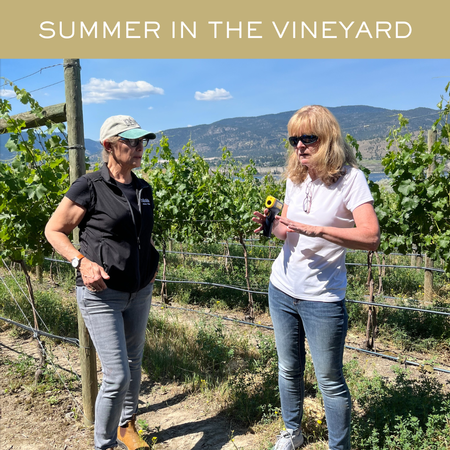Our July 2020 blog post gave an overview of what happens in the vineyard through the summer and how critical good vineyard management is.
“The quality of the fruit and the health of the vines are ensured through good canopy management. The canopy is made up of all the green growth which arises from the canes in each growing season. This means growing just the right sized vine to provide energy to ripen the fruit with enough nutrients left to store in the root system through the winter for the start of next growing season, and no more.”
But how this is achieved varies from year to year, depending on growing conditions. Unlike summer 2021 which started with the bang of an unprecedented heat dome, the 2022 growing season began with a whimper. Due to a cool spring, budbreak was about the latest it could be, and a very rainy June set bloom back to our latest ever (June 25th). July followed with higher than normal temperatures, after all the rain causing an explosion of growth in the vines. While the heat had winemakers heaving sighs of relief, this set of circumstances put enormous pressure on our vineyard crew as they struggled to stary ahead of the need for shoot thinning, tucking & tying, shoot positioning and leaf removal, while allowing for the necessary sprays to keep powdery mildew at bay.
As neither our terrain or our budget allow for much automation in the vineyard, all work is done manually except for mowing and spraying. While this ensures the degree of care and attention to detail we like to see in our vineyards, it does put a strain on our labour force. At one point the crew had to go through and tuck only every second row in order to keep ahead of the tractor so that it could go through with a much-needed spray. Later a second pass was needed to finish the job.
Speaking of tractors—fun fact—the one used on our vineyard is on tracks rather than tires—like a bulldozer. Super cool and super good for the soil as the tracks spread the weight and limit compaction. Our vineyards are managed by Premium Vineyard management, the crew who also look after a number of our contracted vineyards so they have hands on over 40% of our fruit intake.
We know how critical vineyard managers are to the quality of our wine and this year started hosting grower meet and greet sessions to create a forum where our growers and some of our neighbours can come together and discuss the joys and trials of growing specific varieties. The first focussed on Pinot Gris—the other “heartbreak grape” and we found that everyone learned something—including that the Hillside Bistro kitchen puts together a killer charcuterie board.
We talked a lot about what makes good grapes and good wine, and then tasted pinot gris from our portfolio.
Next was merlot, and lucky for us, that grower list includes Dr. Pat Bowen and Carl Bogdanoff viticulture researchers recently retired from Agriculture Canada’s Summerland Research Center. The first question we had for them after the cool spring was “will the vines catch up?”, the answer from Carl a quick, disappointing “No! What red grapes need is long hang-time, so hope for a long warm fall.”
Pat was quick to follow up on ways to help make the best of the situation, explaining that anything that can be done to encourage heat on the fruit will help the process. “Do your leaf removal now, while the berries are small, so they toughen and don’t get sunburnt later on.” They’ll need to have that direct exposure later in the season to ripen the tannins. “And for goodness’ sake, mow between the rows. Vegetation on the vineyard floor can lower the temperature of the fruiting zone by up to 4 degrees!”
We went over to their place, the Occhi Dolci vineyard, a few days later to learn more. Pat had a thermometer gun that she aimed first at open ground, then the vineyard row, then at a clump of mustard, chamomile, and purple vetch that the mower had missed—big temperature variation. These plants are beneficial, attracting harmful critters like gophers and cutworm away from the vines and encouraging helpful insects to stick around. “But they’ve done their work for now. Now you need the heat.” Pat explained.
Our next grower meet & greet is scheduled for mid-September, that tiny lull between the constant canopy work requirement and harvest. We’re looking forward to engaging all growers, all varieties. There will likely be some more tasting as well….
